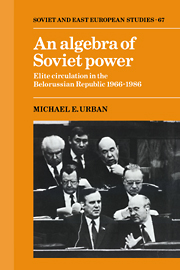Book contents
- Frontmatter
- Contents
- List of figures and tables
- Preface
- Acknowledgements
- 1 Method, model and historical background
- 2 Hierarchy, mobility and a stratified model
- 3 Centralization as a determinant of elite circulation
- 4 The regional structure of elite circulation
- 5 The structure of patronage affiliations
- 6 Does faction make a difference?
- 7 Political succession
- 8 Conclusions, implications and the question of levels
- Appendix A Stratification of positions in the Belorussian Republic, 1966–86
- Appendix B A roster of factional groups in the Belorussian Republic, 1966–86
- Notes
- Index
- Soviet and East European Studies
2 - Hierarchy, mobility and a stratified model
Published online by Cambridge University Press: 09 November 2009
- Frontmatter
- Contents
- List of figures and tables
- Preface
- Acknowledgements
- 1 Method, model and historical background
- 2 Hierarchy, mobility and a stratified model
- 3 Centralization as a determinant of elite circulation
- 4 The regional structure of elite circulation
- 5 The structure of patronage affiliations
- 6 Does faction make a difference?
- 7 Political succession
- 8 Conclusions, implications and the question of levels
- Appendix A Stratification of positions in the Belorussian Republic, 1966–86
- Appendix B A roster of factional groups in the Belorussian Republic, 1966–86
- Notes
- Index
- Soviet and East European Studies
Summary
The rather modest purpose of this chapter - the construction of a stratified model of offices for the Belorussian Republic which can be used to analyse elite circulation in the chapters that follow - immediately confronts a thicket of complications raised by our discussion of the Soviet form of organization. Taking, first, the question of intraorganizational hierarchies, it would appear that the relative absence of a bureaucratic pattern of organization in the USSR would raise serious questions about the utility of relying simply upon the nominal designations of the various offices in order to arrive at an adequate conception of how power and authority are actually distributed among them. If, for instance, communications among these offices do not consistently conform to bureaucratic rules whereby orders are passed along an explicit chain of command, but instead involve numerous cases in which middle-level offices are bypassed in the course of direct communications between ‘top’ and ‘bottom’, we cannot safely infer that the formal standing of offices in Soviet organizations is coincident with their operational or practical significance. Consequently, formal rank emerges as a rather imprecise index of the gradations in power and authority that may in fact prevail in Soviet organizations. In what follows, we find that this is also true for the mobility of actors within formal organizational hierarchies.
Secondly, there is the matter of what may be regarded as multiple hierarchies in the Soviet system - the array of party jobs, state jobs, and jobs in mass organizations or Soviets - all of which intersect in various committees and bureaux at various levels.
- Type
- Chapter
- Information
- An Algebra of Soviet PowerElite Circulation in the Belorussian Republic 1966–86, pp. 18 - 35Publisher: Cambridge University PressPrint publication year: 1989



